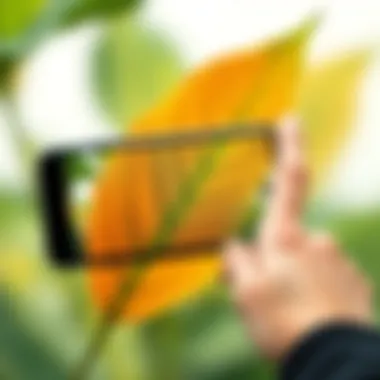Top Free Apps for Plant Identification by Picture


Intro
As the world's complexity unfolds, many find solace in the simplicity of nature. Gardening enthusiasts, casual strollers, and researchers alike often encounter the challenge of identifying plants in their surroundings. With smartphones in nearly every pocket, there is an opportunity to bridge the gap between curiosity and knowledge. Free applications that identify plants through images promise to provide quick answers, transforming a fleeting moment of wonder into a learning experience.
These tools use cutting-edge technology to analyze pictures and return a wealth of information about the plants captured. Their potential reaches far beyond identifying species — they offer insights into care tips, growth patterns, and ecological relevance. In this article, we'll explore several popular applications that aim to help users recognize plants effortlessly and understand their importance.
In a world increasingly reliant on technology, these plant identification apps stand out not only for their utility but also for their user interactions. Whether you’re an experienced botanist or simply someone who enjoys a good weekend walk, these applications can deepen your appreciation for the flora around you.
Why Use Plant Identification Apps?
In an era where information is just a click away, plant identification apps serve several purposes:
- User-friendly interface: Most of these applications are designed with ease of use in mind. You snap a photo, and the app does the heavy lifting.
- Educational resource: These apps don't just tell you what plant you are looking at but also provide valuable information about its habitat, uses, and care.
- Encouraging engagement: Learning about plants boosts environmental awareness, sparking interest in gardening or conservation efforts.
The integration of technology with nature education is changing how we interact with our surroundings. This journey to identify plants can be not only informative but also engaging, as it encourages users to step outside and appreciate what nature has to offer.
In the sections that follow, we will dive deeper into specific applications, their functionalities, and how well they perform in real-world scenarios. The goal is to provide you with a nuanced understanding to make an informed choice about which app might best serve your needs.
Preamble to Plant Identification Technologies
Understanding plants is much more than knowing how they look; it involves recognizing their role in our ecosystems, identifying their needs, and learning how to nurture them. In this age where smartphones are practically an extension of ourselves, plant identification technologies have evolved significantly, allowing enthusiasts and professionals to explore botany with unprecedented ease. This section will examine the significance of plant identification technologies, providing a lens through which we can appreciate the myriad of features they offer.
The Importance of Plant Identification
Today, knowing one's plants is crucial, especially in increasingly urban environments where green spaces are often limited. More than mere curiosity, accurate identification can lead to improved garden maintenance, informed choices regarding plant care, and an expanded understanding of biodiversity.
Many people struggle with identifying plants, leading to incorrect gardening practices and even negative impacts on local ecosystems. For instance, confused gardeners might inadvertently introduce invasive species or neglect native plants. This can have substantial effects, from biodiversity loss to changes in habitat, affecting everything from local insects to larger wildlife. By utilizing plant identification apps, users can quickly determine a plant's characteristics and needs, promoting a more harmonious relationship with nature. Moreover, these tools foster educational opportunities, encouraging users to deepen their knowledge about plants and their ecological significance.
Historical Context of Plant Identification Methods
Historically, plant identification relied heavily on expert knowledge, field guides, and extensive experience. If you rewind a couple of centuries, you'd see botanists trudging through fields, collecting samples, and meticulously documenting their findings. Something as simple as distinguishing between two similar looking species could take a seasoned professional years of study. The process wasn’t just tedious; it was often inaccessible to the everyday person.
In the 20th century, developments in photographic techniques began to change the game. Field guides became abundant and manageable for amateur enthusiasts. However, one still needed to have a keen eye and significant background knowledge. Fast forward to the present day, the advent of artificial intelligence and database-driven solutions has led to a revolution. Now, smartphone apps harness the power of machine learning, making it possible for users to identify plants simply by taking a picture. No longer limited to experts, the world of botany is now within everyone’s reach. This democratization of plant identification exemplifies how technology can transform traditional fields, enhancing accessibility and engaging a larger audience in botanical exploration.
Overview of Mobile Technology in Botany
The intersection of mobile technology and botany has sparked a revolution in how we interact with the natural world. Traditional plant identification often involved time-consuming methods, ranging from field guides to consulting experts. In contrast, mobile applications provide instant access to a wealth of botanical knowledge at our fingertips, transforming our approach to understanding flora. The integration of technology into plant identification streamlines the learning process, making it accessible not only to enthusiasts but also to casual observers and researchers.
The Rise of Smartphone Usage
Smartphones have become ubiquitous in modern society, and their impact on botany cannot be overstated. As more people carry around devices equipped with powerful cameras and internet access, the opportunity for spontaneous plant exploration increases. Users can snap a quick photo of a plant they encounter and receive immediate feedback on its identity. This convenience fuels an interest in gardening and conservation, as newfound knowledge encourages individuals to cultivate and protect diverse plant species. Moreover, smartphones enable the sharing of information through social media and forums, creating a vibrant community of plant lovers who contribute to collective learning.
- Convenience: The ability to identify plants in real-time, without needing to carry around heavy field guides.
- Community Engagement: Users can share discoveries and ask questions from fellow botany enthusiasts across platforms like Reddit or specialized forums.
- Accessibility: Individuals from all walks of life can engage with botany and gardening, regardless of prior knowledge.
Advancements in Imaging Technology
The technological advances in imaging capabilities have significantly impacted how plant identification apps function. High-resolution cameras, combined with sophisticated software, enable these applications to analyze images in detail. Features such as macro photography allow users to capture intricate details of leaves, flowers, and stems, improving the accuracy of identifications. Furthermore, with the latest developments in augmented reality (AR) and machine learning, some apps offer interactive experiences where users can visualize information in real-time.
These enhancements also address some challenges faced by older methods, including:
- Detail Detection: Modern cameras can capture finer details that may lead to more accurate IDs.
- Real-time Feedback: Users often receive immediate suggestions about a plant based on captured images.
- User Adaptability: As imaging technologies improve, apps can adapt their algorithms, increasing their efficiency and relevance.
"The advances in smartphone imaging help create an interactive relationship between users and plants, enriching our understanding of the environment."
In summary, mobile technology's contribution to botany has both broadened access to knowledge and improved plant identification accuracy. These developments invite more individuals to explore the world of plants and foster a community keen on protecting our natural resources.
How Plant Identification Apps Work
Identifying plants using mobile applications has become as simple as capturing a photo and pressing a button. The importance of the technology underpinning these apps cannot be overstated. Understanding how these applications function is crucial for both casual users and serious plant enthusiasts alike. They bridge the gap between curiosity and knowledge, allowing anyone with a smartphone to unlock the mysteries of the botanical world. Let’s delve into the key components that enable these applications to deliver accurate plant identifications.
Machine Learning and Image Recognition


At the heart of most plant identification applications lies machine learning. This branch of artificial intelligence utilizes algorithms to learn from data and improve over time. When a user takes a picture of a plant, the app employs image recognition technology to analyze the visual features of the image.
Here’s how it typically works:
- Data Input: The app takes the photo you’ve snapped. It then preprocesses the image to enhance clarity, focusing on key features like color, shape, and texture.
- Feature Extraction: After preprocessing, the machine learning model extracts important features from the image. For instance, a leaf's serrated edge or the flower's color can be distinguishing factors.
- Matching Algorithm: This extracted data is then compared against thousands or even millions of images stored in vast databases. The algorithm determines which known plant most closely matches the picture taken by the user.
Importantly, not all apps utilize machine learning in the same manner. Some may rely heavily on user-uploaded data to improve accuracy, while others may benefit from inputting data from botanical databases. The more data the app ingests, the smarter it gets, and this integration leads to higher identification rates.
For example, apps like PlantSnap leverage a wide array of species images to enhance the ability of their algorithms to discern subtle differences between similar plants. This learning process exemplifies the potential for future updates and refinements, continuing to improve the app's effectiveness.
Data Sources and Reference Databases
As important as the algorithms is the data they draw from. If you think about it, the quality of the identification will greatly depend on the data sources and reference databases that the app uses. Generally, apps pull information from several repositories, including:
- Botanical Gardens and Research Institutions: Certain apps collaborate with institutions, tapping into their extensive databases which house thousands of plant species.
- User Contributions: Some applications thrive on community sharing. Users can submit images of plants, verifying them through peer review. This collaborative effort expands the database rapidly.
- Public Databases: Major databases such as the U.S. Department of Agriculture's PLANTS Database serve as reliable reference points for plant identification.
In the digital age, the fusion of technology and botany can lead to incredible growth in knowledge and conservation efforts. However, there are also hurdles. Issues such as classification discrepancies arise due to regional variations, meaning information could differ between regions. Some plants may have multiple common names, confounding even seasoned users.
Key Features to Look For
When venturing into the world of plant identification applications, understanding the essential features can dramatically influence the results you achieve. As mobile technology proliferates, a plethora of apps offer varied capabilities. Choosing the right app can help streamline your garden care or academic research, making the plant identification process smoother and more efficient.
User-Friendly Interface
A user-friendly interface is crucial for any app, especially for those designed for plant identification. It’s not just about aesthetics; it’s about functionality. The layout should be intuitive, allowing users to navigate without a steep learning curve. If the app looks like a jumbled mess, chances are users won't stick around long enough to appreciate its features.
Features to consider in the interface include:
- Easy Navigation: Users should move from capturing images to receiving identification results with minimal steps. An app that requires too many taps to get to the desired feature can frustrate users.
- Visual Clarity: The use of clear icons, labels, and images can significantly enhance understanding. Well-placed visual cues help users feel more at ease when interacting with the app.
- Customization Options: Allowing the users to rearrange features, menu items, or even color themes can personalize the experience, making them more likely to use the app consistently.
Speed and Accuracy of Identification
In the realm of identifying plants, two pillars stand tall: speed and accuracy. An app that takes ages to deliver results or frequently misidentifies can diminish its value, despite other appealing features it may possess.
- Speed of Processing: Users want quick answers. A good plant identification app should offer near-instantaneous feedback after an image is submitted. Long wait times can lead to user frustration and increase the likelihood of abandoning the app.
- Accuracy: An app needs to be right more often than not. Inaccurate identifications can mislead users, potentially causing harm if they are dealing with edible or medicinal plants. Accuracy is often derived from machine-learning algorithms that refine over time by analyzing large datasets. Apps leveraging vast databases of plant species typically offer more reliable results.
Additional Resources and Learning Tools
Besides just identification, many apps these days enrich the user's experience with additional resources. These can benefit both novice gardeners and seasoned botanists. Having more tools at your fingertips can deepen understanding and foster a greater appreciation for flora.
Some notable resources include:
- Educational Materials: Articles, videos, or interactive tutorials that explain various species’ ecological roles or care needs can enhance the user's knowledge. Learning in context often leads to better retention of information.
- Community Forums: Some apps incorporate social features, allowing users to connect with fellow plant enthusiasts. Such platforms can foster discussions on care tips, identification challenges, and general gardening advice.
- Offline Functionality: The ability to access certain features without an internet connection can be immensely helpful during outdoor explorations. Users shouldn’t have to worry about losing cellular signal while trying to identify a rare plant.
"In the realm of plant identification, the right tools can empower both budding botanists and seasoned horticulturists alike. Whether you’re seeking quick answers or deeper knowledge, selecting an app with the right features makes all the difference."
With these considerations in mind, users can better position themselves to reap the full benefits offered by plant identification applications.
Comparative Analysis of Popular Apps
In the quest for identifying plants through smartphone applications, conducting a comparative analysis of popular options emerges as a crucial step. Each app comes with its own set of features and limitations, and understanding these nuances can significantly influence a user's experience and effectiveness in plant identification. By assessing varied elements—usability, precision, and additional resources—potential users can make informed choices that suit their unique needs.
When it comes to plant identification, the stakes can be high—especially for gardeners eager to monitor plant health, botanists engaged in research, or nature enthusiasts keen on enhancing their knowledge. Without a thorough evaluation, one might end up choosing an app that lacks the capability to provide accurate results or a user-friendly interface.
App A: Features and Limitations
App A serves as an excellent entry point for new users interested in plant identification. Its interface is sleek and intuitive, designed to guide users through the identification method with ease. Key features include:
- Image Recognition: Users can capture photos of plants and receive immediate feedback on the species.
- Community Support: A built-in forum allows users to share experiences and seek advice.
- Resource Database: Comprehensive descriptions and care tips for identified plants enhance user knowledge.
However, it does come with limitations. Some common issues include:
- Occasional Inaccuracies: Depending on the plant type and image quality, results may vary in reliability.
- Limited Database: While App A covers many common varieties, it may struggle with rare or regional plants. This can be especially frustrating for users in diverse biodiverse areas.


App B: Features and Limitations
Continuing the analysis, App B offers a wealth of features that cater to both novices and experienced plant enthusiasts alike. Its standout attributes include:
- High-Resolution Image Analysis: This app excels in scanning and interpreting high-quality images taken in various light conditions.
- User Feedback Mechanism: Users can rate identification accuracy, enabling continuous improvement.
- Learning Modules: Tailored lessons on botany basics help users deepen their understanding of plant biology.
Nonetheless, users may encounter certain drawbacks:
- Performance Issues: Sometimes, the app can lag when processing high-resolution images, which can hinder a smooth experience.
- In-app Purchases: While the base version is free, certain advanced features require payment, which may not sit well with all users.
App C: Features and Limitations
Then there’s App C, which prides itself on a focus toward educational purposes. It has garnered attention for its innovative approach to plant identification. Noteworthy features include:
- Augmented Reality: Blending reality with information overlays, this feature makes plant identification more interactive and engaging.
- Wide Database Access: Users gain access to a variety of species, including lesser-known plants, which is a boon for those in search of biodiversity.
- Interactive Plant Map: An innovative tool that shows where certain plants are commonly located within a geographical area.
However, it too has its limitations. Users have pointed out some pitfalls:
- Steep Learning Curve: The range of features might overwhelm users not familiar with technology.
- High Data Usage: The augmented reality feature can consume a significant amount of data, which may be a concern for users with limited bandwidth.
In selecting an app, consider not only the features each provides but also how those features fit into your specific identification needs and lifestyle.
Thus, this comparative analysis serves as a foundational step for users, aiding them in selecting the best plant identification app that aligns with both their skill level and their goals.
User Experience and Feedback
User experience plays a pivotal role when exploring applications that assist in identifying plants through photography. For users who may not have a background in botany, the ease with which they can navigate these apps can greatly influence their engagement and satisfaction. Feedback from fellow users serves as a litmus test for an app’s effectiveness.
Analyzing User Reviews
When individuals venture into the world of plant identification apps, they often turn to user reviews as a compass guiding their choices. Reviews typically provide insight into the functionality of the apps, shedding light on whether they truly deliver on their promises.
Key aspects frequently highlighted in reviews include:
- Accuracy of Identifications: Users want to know if the app can correctly identify plants. A consensus on accuracy can validate or undermine an app's credibility.
- Ease of Use: Reviews often touch on how intuitive the interface is. Users are looking for apps that allow them to snap a photo and receive quick results without a steep learning curve.
- Support and Responsiveness: Feedback about customer service can influence potential users. An app that promptly addresses issues will generally have a more favorable reception.
Many users share their personal stories surrounding plant identification — whether they were able to identify a rare flower on a hike or learned about harmful weeds invading their garden. These narratives enrich the app's community and offer a glimpse into real-world applications.
Common Challenges Faced by Users
Despite the advancements in technology, challenges abound when using plant identification apps. Understanding these hurdles is crucial for creating a more seamless user experience. Some common issues include:
- Image Quality Dependency: Many apps rely heavily on the clarity of uploaded images. Low-resolution photos often lead to erroneous identifications, leaving users frustrated.
- Species Variability: Plants can greatly vary in appearance. For example, two similar species might require careful examination of minor traits, which apps might overlook if users provide only one angle.
- App Limitations: Certain apps might have a limited database, struggling with identifying less common or regional plants. This limitation can lead to a reliance on forum discussions and external resources for validation.
"No matter the app, experience teaches users to be cautious. It’s essential to cross-reference any identifications, especially when toxicity is a concern."
In summary, dissecting user experiences and feedback reveals a rich tapestry of both appreciation and challenges. Acknowledging the community's insights can empower potential users to make informed decisions, ensuring they choose an app that aligns with their needs.
Implications for Gardens and Conservation
The integration of plant identification applications in gardening and conservation initiatives has had significant implications. These tools offer practical assistance not only to novice gardeners but also to seasoned horticulturists, and environmentalists alike. Users can identify, learn, and engage with plants in their local ecosystems, which fosters a deeper appreciation for biodiversity.
Enhancing Garden Maintenance
When it comes to maintaining a garden, knowing which plants thrive in specific conditions is key. Plant identification apps enable users to easily recognize plant species, which in turn helps in understanding their growth patterns, nutritional needs, and potential pest threats. For instance, if a gardener identifies a particular weed species that competes for nutrients with their cultivated plants, they can quickly address the issue before it becomes detrimental.
- Immediate Action: By allowing users to snap a quick photo and receive instant feedback, these apps enable timely interventions, fostering a more productive gardening experience.
- Personalization: Many apps also offer customized care tips based on the identified plant's species, temperature preferences, and other environmental factors.
- Record Keeping: Users can maintain logs of which plants they have identified, their locations, and any care they've provided, facilitating an organized approach to garden maintenance.
This simple yet effective use of technology not only enhances the physical health of gardens but also supports strategic planning based on seasonal changes and plant development cycles.
Conservation Efforts and Education
On the conservation front, the potential for plant identification apps is monumental. These tools serve as educational platforms, raising awareness about plant diversity and the importance of preserving it. Users engage in identifying local flora and can contribute valuable observational data back to conservation organizations.


- Citizen Science: Many apps encourage users to join citizen science projects. Participants can report their findings, which helps scientists build databases that reflect plant distributions and biodiversity health.
- Awareness Campaigns: App developers often collaborate with ecological organizations to disseminate information regarding endangered species. Users educated through the app can become advocates for plant conservation in their communities.
- Youth Engagement: Engaging younger generations through gamified learning experiences can spark an interest in botany and environmental stewardship. This not only cultivates future environmentalists but also empowers today’s youth to take an active role in conservation efforts.
"Using technology to connect people to plants can create a more informed society, one that recognizes the delicate balance of ecosystems."
Challenges in Plant Identification
The intricacies of identifying plants through digital means come with their own set of hurdles. Understanding these challenges is crucial for both casual enthusiasts and serious botanists. With the rise of technology, one may assume that plant identification has become a walk in the park. However, the reality is much more nuanced.
Variability in Plant Species
Plant species can present as a double-edged sword when it comes to identification. The wide range of species, each exhibiting different morphological traits, can bewilder even seasoned professionals. Take, for instance, the plant genus, Corylus, where subtle variations can appear between similar species. One's eye might catch the familiar catkins, but discerning between Corylus avellana (common hazel) and Corylus americana (American hazelnut) can be quite the task without clear context. This variability extends even further among hybrid plants, which often feature attributes from multiple parent species, complicating the identification further.
Furthermore, consider how environmental factors affect plant morphology. For instance, a plant subjected to drought conditions may appear dwarfed compared to its well-watered counterpart, leading to erroneous identification. Such variability can throw a wrench in the identification process, highlighting the need for high-quality imagery along with contextual information, like geographic location and growing conditions.
Limitations of Current Technology
Even with all the advancements in technology, current plant identification apps are not without limitations. A key factor lies in the algorithms employed, which are often based on machine learning techniques. These algorithms have been trained on datasets that may not encompass the full variety of plant species or their variations, leading to misidentifications.
Moreover, image quality plays a pivotal role. A poor photo—with low resolution or inadequate lighting—can drastically affect accuracy. For instance, an app may struggle to identify a plant if the picture appears grainy or if the leaves are obscured by shadows. Not only that, but the app's performance might greatly vary depending on the geographic area in which you are using it. Some applications may be robust in identifying species native to certain locales while floundering in unfamiliar territory.
It's also worth noting the reliance on user-supplied data, such as additional descriptions or characteristics of the plant. While this can enrich the identification experience, it also opens the door for subjective input which can mislead the system.
”The beauty of nature is often wrapped in complexity.”
In light of these challenges, it's essential to approach plant identification apps with a critical eye. While they are tremendously helpful tools, understanding their constraints can help users make better-informed decisions when identifying the flora around them. Without this understanding, one may find themselves lost among the leaves, misguiding their own investigations, or worse—making erroneous conclusions about a plant’s characteristics and uses.
Future Directions in Plant Recognition Technology
The field of plant recognition technology is swiftly evolving, making it a fascinating area for exploration. With the growing importance of biodiversity, gardening, and a heightened awareness of our natural environment, the future directions in this technology are not just exciting—they're vital. As smartphone applications become more sophisticated, the focus shifts towards not only identifying plants with accuracy but also integrating these capabilities into broader ecosystems of technology.
Integration with Other Emerging Technologies
One notable trend is the integration of plant identification apps with other emerging technologies, such as augmented reality (AR) and geographic information systems (GIS). By employing augmented reality, users could overlay real-time plant data on their visual landscape. Picture this: you walk through a park, and by using your smartphone, you get instant details about trees and flowers, including their ecological significance and growth habits, simply by pointing your camera.
GIS can complement this technology by aiding in the mapping of plant life across different ecosystems. With precise locational data, conservationists can monitor endangered species or track the spread of invasive plants. This cross-pollination of technologies not only enhances environmental understanding but also supports education, making complex data easier to digest for casual users. The merging of identification tools with GIS could facilitate crowd-sourced data, creating databases that help scientists understand how climate change affects different species migration and population dynamics.
Potential for Artificial Intelligence Enhancements
The future also holds tremendous potential for artificial intelligence (AI) enhancements within plant identification apps. AI algorithms are becoming increasingly adept at learning from user inputs and improving identification accuracy over time. You could start noticing that an app learns your specific preferences. For example, if you frequently explore ferns, it might prioritize ferns in its identification suggestions.
Moreover, machine learning can analyze vast datasets containing images and information about plant species at an unprecedented rate. An AI model trained with thousands of images can identify subtle differences between species much better than any human expert. This means a lower chance of misidentification, which can sometimes lead to misinformation, especially concerning edible plants.
With algorithms capable of processing not just photographs but also environmental variables—like humidity and soil type—AI could suggest the best plants for your local garden conditions. Users may soon benefit from AI-generated gardening advice, taking personal preferences and hardship into account.
Finale and Recommendations
In wrapping up this exploration of free applications aimed at identifying plants by pictures, there's no denying the profound impact these tools have on both casual enthusiasts and dedicated horticulturists alike. The journey towards mastering plant identification can often be daunting, given the sheer diversity of flora present in various ecosystems. Thus, understanding how to properly choose and utilize these applications becomes crucial for anyone keen to delve deeper into botany.
Choosing the Right App for Your Needs
When it comes to selecting the right plant identification app, a few key factors should be carefully considered. First and foremost, evaluating the user-friendly interface is paramount; you’d want an app that doesn't resemble a jigsaw puzzle just to identify a sunflower, right? Look for features such as clear navigation, straightforward options for inputting images, and an easily accessible database of potential identifications.
- Customization: Some apps allow you to adjust settings based on your expertise level, enabling tailored experiences that can grow with your knowledge.
- Offline Access: For those in remote areas or national parks, having offline capabilities might just be your saving grace. Not every place has reliable service, but the green world waits for no one.
- Community Engagement: Apps that foster a community of users can enhance learning. Whether through discussion forums or social media integration, sharing experiences can enrich your understanding.
Finally, never underestimate the power of feedback and reviews. Checking out what other users have to say about a specific application provides insight that can save you time and mean the difference between a delightful outing and endless frustration.
The Broader Impact of Plant Identification Tools
The implications of using plant identification tools stretch far beyond individual enjoyment; they contribute significantly to broader ecological awareness and sustainability efforts.
"Understanding our natural surroundings can inform conservation efforts and encourage responsible interactions with the environment."
With every plant accurately identified, there's a ripple effect. Here are a few notable impacts:
- Education: These apps help users learn about plant species which can foster appreciation and respect for biodiversity.
- Conservation: Accurate data on plant types can aid researchers and conservationists; they can track species health or spot invasive varieties in areas where they shouldn’t be.
- Community Building: Many enthusiasts find camaraderie in their shared love of plants. This builds networks which can mobilize local efforts to preserve habitats.
As we continue to embrace this technology, it’s essential to remember its educational potential. With each photograph uploaded and identified, users not only enhance their personal knowledge but also contribute to a collective understanding of our planet's diverse ecosystems.
In summary, by carefully choosing the right app and utilizing its full potential, users can amplify their connection to nature while also supporting conservation initiatives, thus paving the way for a greener future.



